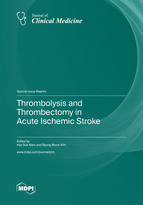Thrombolysis and Thrombectomy in Acute Ischemic Stroke
A special issue of Journal of Clinical Medicine (ISSN 2077-0383). This special issue belongs to the section "Clinical Neurology".
Deadline for manuscript submissions: closed (30 April 2022) | Viewed by 44146
Special Issue Editors
Interests: reperfusion therapy; outcome predictor; neurosonology; artificial intelligence; mobile health; translational research
Special Issues, Collections and Topics in MDPI journals
Interests: endovascular thrombectomy; endovascular treatments; aneurysm; dissection; arteriovenous malformation; outcome predictor
Special Issues, Collections and Topics in MDPI journals
Special Issue Information
Dear Colleagues,
Previously, intravenous tissue plasminogen activator (IV tPA) within 4.5 h of stroke onset was the only therapy for acute ischemic stroke. However, the recanalization rate of IV tPA is not satisfactory. After successful randomized clinical trials, endovascular thrombectomy (EVT) has been a standard of care for patients with acute ischemic stroke due to large artery occlusion within 6 h of onset. Guidelines still recommend that patients eligible for IV tPA should receive IV tPA even if EVTs are being considered. Recently, two randomized clinical trials demonstrated that EVT, even in the late time window of up to 16 or 24 h after the last known normal time. Expanding the time window of EVT up to 24 h would have a significant impact on the stroke care system. Many researchers have conducted numerous studies to search for more effective treatments, evaluation tools, and efficient care pathways.
This Special Issue of the Journal of Clinical Medicine will cover the following important aspects of IV thrombolysis and EVT in acute ischemic stroke:
Prehospital stroke management;
In-hospital or interhospital care system;
Acute brain imaging;
Emergency evaluation and treatment;
Intravenous thrombolysis;
Endovascular thrombectomy;
Patient care after IV tPA and EVT;
Outcome predictors of reperfusion therapy.
Prof. Dr. Hyo Suk Nam
Prof. Dr. Byung Moon Kim
Guest Editors
Manuscript Submission Information
Manuscripts should be submitted online at www.mdpi.com by registering and logging in to this website. Once you are registered, click here to go to the submission form. Manuscripts can be submitted until the deadline. All submissions that pass pre-check are peer-reviewed. Accepted papers will be published continuously in the journal (as soon as accepted) and will be listed together on the special issue website. Research articles, review articles as well as short communications are invited. For planned papers, a title and short abstract (about 100 words) can be sent to the Editorial Office for announcement on this website.
Submitted manuscripts should not have been published previously, nor be under consideration for publication elsewhere (except conference proceedings papers). All manuscripts are thoroughly refereed through a single-blind peer-review process. A guide for authors and other relevant information for submission of manuscripts is available on the Instructions for Authors page. Journal of Clinical Medicine is an international peer-reviewed open access semimonthly journal published by MDPI.
Please visit the Instructions for Authors page before submitting a manuscript. The Article Processing Charge (APC) for publication in this open access journal is 2600 CHF (Swiss Francs). Submitted papers should be well formatted and use good English. Authors may use MDPI's English editing service prior to publication or during author revisions.
Keywords
- intravenous thrombolysis
- endovascular thrombectomy
- tissue plasminogen activator
- brain imaging
- stroke care system
- outcome








